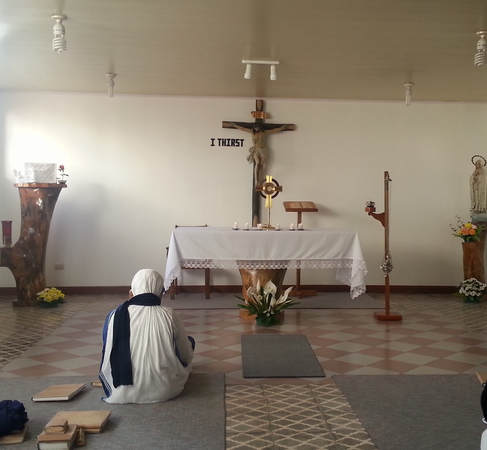 The simple reverence with which the Missionaries of Charity adore the Lord (the chapel in Costa Rica where I gave a retreat last month."
The simple reverence with which the Missionaries of Charity adore the Lord (the chapel in Costa Rica where I gave a retreat last month." Ending the Ecclesial Crisis: The Fatima Perspective
Lecture Title: Recovering the Ancient Liturgy in San Francisco
by Fr. Joseph Illo
PART TWO of THREE
Altargate
In August 2014 I was assigned to Star of the Sea Parish in San Francisco. My predecessor had laudably begun offering the Latin Mass every day, so many were growing in reverence for the Holy Sacraments. The casualness and even indifference toward the Holy Eucharist at the English Masses, however, was rather discouraging. Where does one begin when so many did not seem to realize what they were receiving in their outstretched hands? We began with the altar servers. I’ll never forget my first funeral at the parish, served by two girls from the school. They did the best they could, but neither was Catholic.
So going forward, we decided to train only Catholic boys to serve the Mass. Some in the parish and many in the school expressed concern with this decision, but all was relatively quiet for three months. Then, the day before the Walk for Life West Coast, the second-largest prolife march in the country, a CBS camera crew stopped me after the noon Mass. “We have heard that you have banned girls from the altar,” the reporter said. “We’d like to interview you.”
I gave a brief interview, making the simple point that, while the Church permits altar girls, it encourages priests to develop boys’ server programs, especially to form priestly vocations. I referenced the 1994 directive from Holy See permitting altar girls: “The Holy See wishes to recall that it will always be very appropriate to follow the noble tradition of having boys serve at the altar. As is well known, this has led to a reassuring development of priestly vocations. Thus the obligation to support such groups of altar boys will always continue.”
That night, however, “altargate” was the first story on the evening news. Two grim-faced news anchors appeared on the screen to alert the public to credible reports of a priest banning girls from a church in San Francisco. The next day NCB’s “investigative unit” was parked outside the church. They certainly had not been assigned to City Hall, were 50,000 pro-lifers were calling for civil rights for the unborn. On Monday a camera crew showed up from Good Morning America, and I eventually received over 1000 emails and letters from around the world. “Altergate,” the scandalous news story of a priest in San Francisco who had banned girls from the altar, had gone viral.
Why had the media pounced on a little parish doing what lots of other big and little parishes were already doing? At first I thought it was only the usual pro-abortion agenda: airing a Catholic-Church-Hates-Women story the night before a massive pro-life Walk. But as the story grew, I saw something deeper was at play. It was really a dispute about the Mass, about our orientation and disposition toward the Presence of God in the Sacred Liturgy.
Purity and Reverence
The Sacred Liturgy, offered reverently, rebukes impurity. Its modesty, its restraint, and its humility stands athwart the arrogance of this world. The world tolerates the Mass, but only if it is reduced to a kind of social gathering. If the priest and people at Mass commit themselves to divine mystery, to Christian solemnity and transcendence, the world becomes very nervous about the Mass. Ultimately it cannot tolerate true reverence and modesty. Contemporary expressions of divine liturgy, for example, find veils embarrassing. Veils point to a mystery that must be modestly concealed, lest we imagine we understand the mystery. Veils cover the most sacred parts of the liturgy—the tabernacle, the chalice and paten, and the priest himself (the chasuble). They are unveiled only at the most sacred moment, when the body of the Lord is to be communicated to the faithful. In authentic expressions of the divine, modesty veils the tabernacle, chalice, priest and the faithful themselves (Psalm 96 exhorts us to “worship the Lord in holy attire”). A church in which the tabernacle stands naked, the chalice remains unclothed, and the priest neglects to vest himself properly communicates impurity. People will dress beautifully and modestly for Mass if the priest is vested in modest beauty, and if the chalice and tabernacle are arrayed in splendor.
The Holy Mass, especially the older usage, quietly rebukes the impurity of our voyeuristic culture. That is why it is opposed and attacked. A few weeks after my brief moment of fame in the evening news, I had dinner with a trusted friend, an older San Francisco priest who had himself been through the wars. “They are not persecuting you for any other reason than that you celebrate the Latin Mass,” he said. “They will oppose you implacably as long as you offer the Mass like that.”


 RSS Feed
RSS Feed